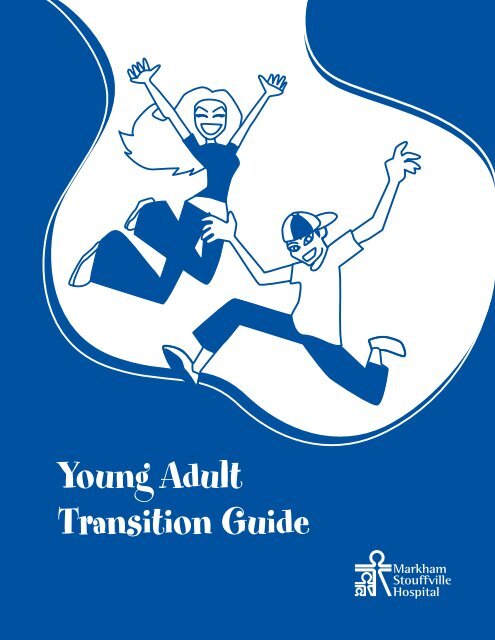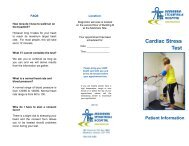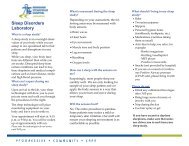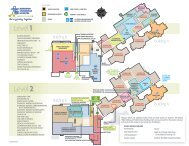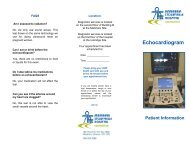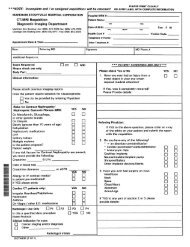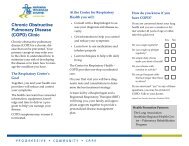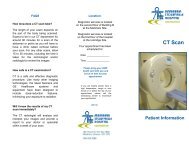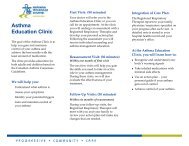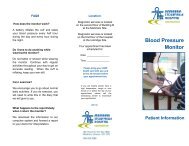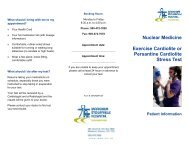Young Adult Transition Guide - Markham Stouffville Hospital
Young Adult Transition Guide - Markham Stouffville Hospital
Young Adult Transition Guide - Markham Stouffville Hospital
Create successful ePaper yourself
Turn your PDF publications into a flip-book with our unique Google optimized e-Paper software.
THE YOUNG ADULTSGUIDE TO TRANSITIONIn your eighteenth year you will be leaving our Paediatric Diabetes Clinic and willbe moving on to an adult diabetes clinic for your diabetes care. This resource is tohelp guide you through the last two years of your paediatric care.There are many issues that are important to discuss before you leave the paediatricclinic and this booklet has been developed to assist you. The responsibilityof recording your own important health information helps prepare you forindependence in your diabetes management.Over the course of the next 4–6 clinic visits, different topics from the booklet willbe discussed with you. There will also be several interactive handouts for you tokeep. By your final visit all of the included documents will have been reviewedand discussed. The completed booklet is for you to keep. Please feel free at anyappointment to ask questions or give comments on the material reviewed.1
Table of Contents—<strong>Transition</strong> <strong>Guide</strong>Section A: Introduction✦ Tracking sheet 3✦ Checklist 4✦ <strong>Adult</strong> diabetes clinic: terminology 5✦ What to expect from the adult diabetes team visit 6Section B: Management✦ A review of insulin action profiles 7✦ Relationship of HgA1C to average blood sugar 8✦ Meal Planning 9✦ When you are sick 10✦ Use of glucagon for severe hypoglycemia 11✦ Use of glucagon for illness 12Section C: Lifestyle✦ Alcohol 13✦ Smoking 15✦ Drugs 16✦ Driving 17✦ Personal Matters 18✦ Heading off to College or University 19✦ What to tell your roommate 20✦ Traveling 21✦ Employment 23✦ Financial 24Section D: Complications✦ Complications and how to avoid them 25Section E: Resources✦ Resource list 262
INTRODUCTIONThis initial section is designed to help you keep track of what you should expect at futureclinic visits. It also provides a way to keep track of the skills and information that you willbe talking about with the team.Tracking Sheet for each visitDateHbA1C (
<strong>Young</strong> <strong>Adult</strong>’s ChecklistTopics CoveredSignature ofteam member❏ <strong>Adult</strong> Diabetes Clinic Terminology❏ A review of insulin action❏ Relationship of HbA1C to average blood sugar❏ Meal planning❏ Use of glucagon for severe hypoglyceria❏ Use of glucagon for illness❏ When you are sick❏ Alcohol❏ Smoking❏ Drugs❏ Driving❏ Personal Matters❏ Heading off to College or University❏ What to tell your roommate❏ Traveling❏ Employment❏ Financial❏ Complications4
<strong>Adult</strong> Diabetes Clinic: TerminologyThe main goal of diabetes management is to achieve blood sugars that are as close to normal as possiblewithout causing too many low blood sugars. Now that you are older and moving into an adult healthcare setting, you will be expected to achieve lower blood sugar readings than you did when you wereyounger. More aggressive and intensive treatment of your diabetes may be necessary to achieve thesetargets. Remember that the lower your HbA1C over time the less likely you are to develop complications.(pg. 25 on complications)When you attend an adult program you may be asked to change your insulin dose or routine. Thefollowing are some of the terms that you may hear in the adult clinic.Multiple daily injections (MDI)— 4–5 insulin injections of fast acting insulin per daycombined with 1–2 injections of a long acting insulin. Fast acting insulin is taken prior to eachmeal and insulin dose is based on the amount of carbohydrate that is to be eaten at that time.The benefit of MDI is flexibility in timing and amount of food. Properly used MDI has beenproven to lower HBA1C.Basal and Bolus Insulin— Basal insulin refers to your long acting insulin Lantusand Levemir when you are on MDI. If you are on a pump, it refers to the continuous flow ofbackground insulin. Basal insulin covers your non food insulin needs.Bolus doses of unsulin are given prior to the mealtime intended to cover your food needs.Correction dose—insulin given to account for blood sugar levels that are above thetarget range. For example:Actual blood sugar target range 4–8Actual blood sugar 12mmol/LA correction is given to bring blood sugar back down the target range. The correction dose isindividualized by your physician.Carbohydrate counting—determining the amount carbohydrate you plan to eat at eachmeal using food labels and nutrient tables.Insulin to carbohydrate ratio—the amount of Carbohydrate you eat determines howmuch insulin you need to cover a meal. Protein and fat that you eat are absorbed more slowlyand have little effect on your blood sugar level. Your insulin to carbohydrate rates will cover yourusual amounts of protein and fat, as well as your carbohydrate in that meal.A typical ratio of 1 unit of insulin per 10 g of Carbohydrate, you would need 6 units of insulin fora 60g carbohydrate meal.5
What to expect fromthe adult diabetes team visitThere will be some changes in your care moving from the paediatric to the adult care setting.The following are some of the new expectations:1. The responsibility is shifted to you to make sure you check your blood sugars regularly and recordreadings in your log book. You need to take control of your care, if you have not already .You may notbe reminded to do these things and you may need to learn how to ask questions of your providerinstead of them asking you all of the questions. For example asking about the latest advances indiabetes management.2. The team will most likely speak to you instead of your parents during your visit.3. The focus will be on maintaining good control of your blood sugars with possibly lower target values.4. Expectations will be to achieve an Hba1C to be less than 7%.5. Insulin regimens may be changed.6. When you are in the adult setting you may not have a diabetes nurse on call. Find out whatyour adult diabetes team wants you to do.7. Your feet will be checked to make sure you don’t have any early signs of complications.8. See your eye doctor at least once a year.9. Your family doctor will continue to be your primary care giver. He/she will continue to provide on-goingmedical support for all of your other health care.6
MANAGEMENTThis section identifies and provides information about important aspects of your diabetescare that you need to know as you begin to take on more responsibility for your health.A Review of Insulin Action ProfilesPROFILEONSETPEAKDURATIONHumalog/Novorapid5–15 min60–90 min2–3 hREGULAR30–60 min2–4 h6–8 hNPH4–6 h8–12 h18–24 hLantus/Levemir1 ½ hnone18–24 h7
The Relationship of Hemoglobin A1C(HbA1C) to Average Blood SugarThe HbA1C is a test that correlates with the average blood sugar over the past3 months. Hemoglobin is the part of the red blood cell that carries oxygen from thelungs to the rest of the body. Sugar sticks to hemoglobin and stays there for thelifespan of the red blood cell — approximately 3 months. HbA1C reflects the averageblood sugar level during that period. The HbA1C should be measured every 3 months.How does the average blood sugar measured translate to HbA1C?Average Blood Sugar (mmol/L)% HbA1C15.5 – 19 mmol/L14 – 17 mmol/L12.5 –15 mmol/L11 – 13 mmol/L9.5 – 11mmol/L8 – 9 mmol/L6.5 – mmol/L12%11%10%9%8%7%6%Canadian Diabetes Association <strong>Guide</strong>lines For Glycemic TargetsFor AdolescentsAge (years)13–18<strong>Adult</strong>A1C (%)
Meal PlanningMany changes may be occurring in your life such as, going away to school, moving outon your own, starting a career and taking on full responsibility for all your diabetesmanagement. At times your diet and exercise routine may not be a priority; However, toperform your best keeping your diabetes under control is essential. Management of yourdiabetes must include healthy eating and regular meals. This requires planning. Here aresome simple suggestions for meal planning.Some simple suggestions for eating and exercise.✦ try to choose at least 3 out of the 4 key foodgroups at each meal• starch• fruits & vegetables• milk• protein foods*Grain &StarchesVegetablesMeat &Alternatives✦ choose portion sizes that will help you reach or maintain a healthy weight• by now you probably have stopped growing taller and do not need as much food as youdid before.• if you are in the habit of filling up on protein choices as “free” foods consider the extracalories they are adding to your diet.✦ try to include high fibre foods such as whole grain breads and cereals, fresh fruits, vegetablesand legumes, and grains (pasta, rice)✦ make lower fat choices (e.g. use skim milk, lean meat and use smaller amounts of addedfat such as butter and salad dressings)• this can be challenging if you are eating out frequently.• have lower fat snacks available like yogurt and fruit instead of chips and granola bars.✦ try to get some physical activity on most days of the week• build time in your routine to get some exercise, walk or ride a bike, go skating, take up anew activity.* For more specific dietary advice speak to a dietitian.* Adapted from Canadian Diabetes Association 2003 Clinical Practice <strong>Guide</strong>lines.9
When you are sickIn the past, your parents have probably managed your diabetes for you while youwere sick. When you are on your own managing an illness can be quite challenging.Here are some guidelines for you to follow.During an illness:✦ Check your urine for ketones every 4 hours and blood sugars every 2–3 hours or even more frequentlyif you are vomiting.✦ Most of the time you should take your usual amount of insulin even if you are unable to eat your usualmeals. However, if you are vomiting or your blood sugar is low you may need to decrease your overallinsulin by 20% of your toal daily dose. If you need help to adjust the insulin dose contact your diabetesteam for advice. If you are both low and vomiting please follow the guidelines for using low dose glucagon.✦ Check blood sugar and urine ketones every 4 hours to assess the need for more insulin. If blood sugar ishigher than 13mmo/L and ketones are present give 10-20% of your total daily dose as extra insulin.To do this add up the amount of all of the insulin that you take in a day (fast acting and long acting) andtake 10% of that as fast acting insulin right away. If the next blood sugar is not lower than 13mmo/L give20% extra the next time your insulin is due. Add the extra insulin to your usual dose.✦ Be sure to drink lots of fluids to prevent dehydration and help flush out any ketones. If blood sugars arehigh drink sugar free fluids and if they are low use sugar-containing fluids.Also use The Sick Day <strong>Guide</strong>lines Pamphlet you will be provided with as an additional resource.10
The Use of Glucagon forSevere Hypoglycemic ReactionsGlucagon is a hormone made by the alpha cells of the pancreas. It raises the blood sugar levelby stimulating the liver to release some of its store of carbohydrate (glycogen) into the bloodas sugar.Glucagon is packaged as a kit with one vial containing 1 milligram (mg) of glucagon as a drypowder, and a syringe preloaded with 1cc sterile diluent. It is to be used when there is asevere hypoglycemic reaction and you are unconscious, or having a seizure, or souncooperative that juice or other concentrated sugar is not safe to be given by mouth.Glucagon should be given by someone else like a roommate.Review these guidelines with a roommate or living companion as you will not be able toadminister the Glucagon yourself.Glucagon cannot be given by mouth. If someone has a seizure call 911.Once unconscious you should be turned on your side.To use the kit*1. remove the cap2. inject the diluent directly from the loaded syringe into the dry powder vial3. roll gently to dissolve4. withdraw the fluid.5. Inject the entire syringe as you would an injection It may take a little time to respond fully, possibly 10–20 minutes. Once alert, it is very importantthat you be given some juice or fast acting sugar, followed by a long acting carbohydrate source.Nausea and vomiting are common side effects and can last up to 24 hours. Your family physicianor diabetes team should be contacted, as you may need to adjust in your insulin dose.*Adapted from the BC Children’s <strong>Hospital</strong> handout “Glucagon for Severe Hypoglycemic Reactions”11
The use of Glucagon duringIntercurrent IllnessRationale:During a time of illness, especially with vomiting and diarrhea, your blood sugar may fall todangerously low levels. This often requires that you may need to go to the emergency room to beput on an IV with glucose. Tiny amounts of glucagon given like insulin can keep the blood sugar upwithout causing vomiting and may be able to prevent a trip to the hospital.How to use Glucagon1. Dilute the glucagon in the usual fashion.*2. Using an insulin syringe draw up 15 units.3. Inject the glucagon under the skin like insulin.4. Check the blood sugar in 30 minutes. It should have risen.5. You may repeat the injections every 2 hours if the blood sugar falls too low again.6. If after 3 injections the blood sugar drops too low, go to the nearest hospital emergency roomfor an I.V.7. If you are not nauseated, continue to drink small amounts of sugar containing fluids.*Once prepared glucagon may be stored in the refrigerator for up to 12 hours.12
LIFESTYLEThis section covers some of the challenges that you can enounter as a teenager havingdiabetes. Here is information and tips on how to safely enjoy your growing independenceand freedom.AlcoholWhat is happening to my body?When you drink alcohol it is absorbed very quickly into your body. The alcohol travels from thebloodstream to the liver. The liver’s function is to remove the alcohol from your body as fast aspossible. It is important to drink slowly because the liver can only remove 1 drink per hour fromyour body. When you drink more than this, alcohol builds up in your bloodstream, which leads tothe symptoms of being drunk. Also, when you have been drinking or are drunk, it is easy to missthe early signs of a low blood sugar because they both appear similar. It is important thatat least one friend knows you have diabetes.It is important to be careful when drinking when you have diabetes because there is a high riskfor getting a low blood sugar. Usually when someone with diabetes has a low blood sugar, theliver produces emergency sugar, but when you are drinking, the liver is too busy processing thealcohol that it is unable to make the emergency sugar. As a general rule, pure alcohol lowersyour blood sugar while a mixed drink with juice or regular pop may raise your blood sugar. It isimportant to bring your glucometer with you so you can catch your “highs and lows” It is alsoimportant to carry juice, candy or something to treat your blood sugar in case your blood sugardrops too low.Getting ready for a night out✦ Stick to your usual meal plan. Drinking should never replace your meals.✦ Check your blood sugar before you go out, but don’t leave your meter at home. You willneed to check your sugars throughout the night.✦ Make sure at least one friend knows that you have diabetes. This is so they can help you incase you have a low blood sugar reaction. Sometimes its easy for friends to think you maybe acting “different” because of the alcohol instead of a low blood sugar.✦ Carry a snack with you.✦ Carry a fast acting sugar with you. (juice, candy, glucose tablets, anything to treat your lows)13
At the party✦ Always choose the sugar free option. So instead of a rum and coke, go for therum and diet coke.✦ Remember to drink slowly. Your liver can only clear one drink an hour from your system.Don’t let that liver of yours work overtime!✦ Never drink on an empty stomach. Since you have followed your regular meal plan you shouldhave already had your dinner by now and if not what are you waiting for? You need to eat!✦ Eat extra snacks for extra activity. If you are dancing at the party you will use extra energy,so you need to eat extra starch or fruit for each 1⁄2 hour of extra activity.✦ Watch for low blood sugars. Having a low blood sugar and drunkenness can sometimes feelthe same. It’s important you test your blood sugar to know what is really going on.Time to Go homeOkay its has been a fun night and now you are home.... now what??✦ Check your blood sugar again and have a snack. Alcohol can cause unexpected changes in blood sugarlevels. Blood sugars may rise initially when drinking, and then may drop several hours later. Alcohol hasdelayed effects on lowering blood sugars, even up to 14 hours.To sleep in or not to sleep in... that is the question.✦ Although it may be tough, it is important to take your insulin and have breakfast at the usual time. Notfollowing your regular routine can be very dangerous to your health. If you are still tired, you can go backto sleep for a few hours.14
SmokingMost people know that smoking causes cancer and breathing problems. But it can also causeother problems, especially if you have diabetes. Smoking and diabetes is a dangerous mix.Smoking decreases the way blood flows through your body, therefore increasing the chance ofgetting long term complications of diabetes including heart disease and amputation.Here are the facts:✦ When you smoke, less oxygen flows inside your body. This can cause a heart attack or a stroke.✦ Smoking damages your blood vessels, which makes it harder for your body to heal.This can lead to infections in your legs and feet which can lead to amputation.✦ If you smoke and you have diabetes, you are more likely to get nerve damage andkidney disease.✦ Smokers are more likely to get colds and respiratory infections.✦ Smoking can lead to impotence.✦ Children are more likely to start smoking if their parents smoke.No matter how long you have smoked it is never too late to quit. Your health will start to improveright after you quit or cut down a lot on the amount that you smoke. Kicking the habit is hardto do — but is worth it.You benefit in important ways when you have diabetes and quit smoking.When you quit smoking, you have:✦ less resistance to insulin✦ less chance of eye damage✦ less chance of kidney damage and kidney failure✦ less chance of nerve damageResults of your blood tests may improve when you quit smoking.Possible effects on your blood test results are:✦ lower A1c levels✦ lower glucose levels✦ lower cholesterol levels✦ lower LDL (bad) cholesterol levels✦ lower triglycerides (fats) levels ✦ higher HDL (good) cholesterol levels15
DrugsThe biggest risk of using street drugs is that it is illegal. Also, what you’ve been told youare getting may not be really be what you get. If you want to take this risk, you maychange your mind after reading the facts below.Marijuana✦ Will impair your judgment so it is likely you will not make the best decisions about food, insulin,activity, sexuality, etc. Because drugs influence the brain there is a higher chance of dosage errors,mistakes about how to respond to blood sugar results and perhaps also timing errors.✦ Causes problems with memory, concentration, sensory and time perception, coordinatedmovement and problem solving, which may effect control.✦ Increases appetite: and can cause overeating, which can lead to hyperglycemia.Opiates/Heroin✦ Can change eating habits, which can affect your blood sugar✦ Alters perception which can affect the ability to manage diabetes.✦ Highly addictiveCocaine✦ Can increase blood sugars and change eating habits✦ Can cause high bloodsugar as a result of increased liver glycogen breakdown✦ Alters perception which can affect the ability to manage diabetes✦ Highly addictiveReference: Campbell K. et al (2003). Effects of legal and illegal substances on diabetes control Diabetes Interview.16
DrivingFor anyone who is planning to get their driver’s license, it is important to remember thatdriving is not a right, but a privilege. All people who intend to drive must prove that theywill be responsible behind the wheel. When you have diabetes you have to make sure thatyour diabetes is well managed and take certain precautions when you drive.Precautions while drivingDiabetes is a condition that has the potential to make driving unsafe. Hypoglycemia is yourgreatest risk when driving, because it can slow your response and reaction time for up to45–60 minutes. This not only puts you in danger but it puts pedestrians, other drivers and yourpassengers in danger. It is recommended that you take the following precautions when driving:✦ Check your blood sugar prior to driving and approximately every 4 hours thereafter if youare on a long trip.✦ If your blood sugar is below 4 mmol/L treat with 15 grams of fast-acting carbohydrate(glucose tablets or regular pop) followed by a snack before driving.✦ Always have a source of fast-acting glucose within easy reach while driving. As well,keep your blood glucose meter with you in the car, along with plenty of snacks in theglove compartment.✦ If you feel like you are having a low blood sugar reaction while driving, immediately stopdriving and treat with fast-acting glucose followed by a snack. Resume driving only whenyour blood sugars have returned to normal (above 6 mmol/L).✦ Always wear your diabetes ID when driving.17
Personal MattersNow that you are approaching adulthood issues of sexual activity, birth control andeventually pregnancy planning must be considered. Decisions on these matters arepersonal but will have an impact on your diabetes. You should be aware of your options.If you are planning to be sexually active and do not want to get pregnant, it is importantto start on a birth control method. There are many options available including birthcontrol pills, the patch and depo shots etc. It may be a good idea to speak to your doctorabout the best option for you. The most important thing to remember is the choices forbirth control methods are the same for those with or without diabetes.Key point: Birth control options are the same for those with or without diabetes.Pregnancy and DiabetesHaving children is a big decision for anyone. If you are a woman who has diabetes, however, it is adecision that requires much more thought and careful planning. Many women who have diabetes havehealthy pregnancies and healthy babies. But this isn’t to say that it’s an easy experience — it requires alot of work and dedication.Importance of planned pregnanciesPoor control of blood sugars before conception and through the first eight weeks of pregnancy greatlyincreases the chances that your baby will develop problems. That is why it is very important to have aplanned pregnancy.You can increase your chances of delivering a healthy baby by keeping your blood sugar in good controlbefore conception and throughout your pregnancy. The first eight weeks are particularly important forthe physical development of your baby.If you plan to get pregnant discuss it with your diabetes team.Cut down or cut out alcoholDrinking too much alcohol during pregnancy can harm your baby. It also affects your blood sugar levelsand can increase your risk of hypos. ‘Less is best’ when it comes to alcohol and, ideally, stop drinkingaltogether until after your baby is born.Try to stop smokingSmoking while pregnant can harm your baby. The effects it has on your child can last well into childhoodand can be permanent. The potential problems caused by diabetes can make smoking even moreunhealthy for you.18
Heading off to College or UniversityTrying to find the right balance between diabetes and school life can be quite challenging. Hereare some hints to help you transition from living at home to living on your own more smoothly.Student tips for Special Arrangements/Housing PlansDuring the enrolment process:✦ Mark the ”disability” box on the application form. This notifies the school that you have amedical condition that may require special attention. This will make things easier once you start.✦ Register at the disabilities office/resource center. Diabetes is not a physical disability, however byregistering at the office, you may be allowed special/preferred housing, parking and meal plans.This allows for the support you may need.✦ Try to get housing that has an open kitchen, or is near a 24-hour food source. A dorm with a latenight cafeteria, or housing near a fast food places, or eating spots on campus.✦ Get a small fridge for your dorm room. This is for storage of emergency snacks or light meals(milk yogurt, cheese, juice) and insulin.✦ Get a meal plan. This is so you will have easy access to food.Dorm set-up:✦ Have your diabetes supplies easily accessible.✦ Have food available for snacks and easy weekend meals.It is important to let the people around you know that you have diabetes, what it means to have alow blood sugar, what symptoms you may have and how to treat it.Take advantage of any resources that may come you way.Many schools offer people registered with diabetes a note-taker for any class you may have missedfor medical reasons. The school must allow you to make up any exams that you may have missedfor that same reason. Some schools may also have affirmative action programs for students withdiabetes. Don’t use diabetes as an excuse, but it is nice to know that these services are available ifyou need them.Not all schools are able to offer all of these services/benefits because of limited resources. Mostcampuses have some form of support teams in place to help students if they need it. Informing asmany offices and people at school that you have diabetes as you can may help the transition fromliving at home to living away as smooth as possible. Some schools have financial resources availablefor supports and supplies.19
Exams✦ Have extra food or snacks available when taking major exams.✦ Inform your test supervisor of your diabetes, and any need you may have.✦ Remember to ‘graze’: strenuous brain activity may affect your blood glucose (sugar) similarto physical activity.✦ If your blood sugar is low during the test, inform your supervisor.✦ Let the supervisor know that your meter may ‘beep” if you need to check your blood glucose(sugar) level. Or if your pump may ”click” when you need to give yourself insulin.What to Tell Your RoommateMoving away from home and living on your own—whether it is away at school or in an apartment withfriends—can be both exciting and scary. There are many new experiences to face. Having diabetes canmake things even more challenging. It is especially important that your roommates are aware that youhave diabetes, and what that means.We suggest that you discuss the following with your roommate.✦ A simple explanation about what diabetes is, what you need to do each day (for example, bloodglucose testing, insulin injections, eating meals and snacks on time).✦ Explain what hypoglycemia is and list your symptoms:Confusion Glassy stare Shakiness IrritabilityMoodiness Incoherence Dizziness✦ Tell your roommate that if you need assistance with treating a low blood sugar how they can help.• Giving 125mL regular pop, juice or glucose tablets.• Tell them that if you should refuse to cooperate, it is still important that they make sure that you eatsomething with sugar in it.• If you aren’t feeling better after 10–15 minutes, they should insist you take more carbohydrate.• If your roommate ever finds you unconscious or having a seizure, at any time, even after partying, orthey cannot wake you up, they should call 911 immediately.• to use glucagon if they have been shown how and are comfortable using it.✦ Have a list of emergency contact numbers readily available. Know where the local hospital is.✦ Have a supply of food somewhere specific in your room, and explain the importance of it beingyour ‘emergency food’, and that it cannot be shared.✦ Provide opportunities for your roommate to ask questions about your diabetes. It may be totallyfamiliar to you, but not necessarily for your roommate, and it may take time for him/her to adjust to it.*Adapted for the BC Children’s <strong>Hospital</strong> handout20
TravelingYour diabetes should not prevent you from traveling anywhere in the world. However,before you set off you need to plan ahead carefully and consider the following information.Preparing for your trip:✦ If you know that you will be traveling through several time zones you will need to adjustyour insulin doses. For example flying East to Europe will shorten your day so you may needless insulin while flying West to Hawaii will lengthen your day so you may require more insulin.Ask your diabetes team for advice.✦ You should also travel with a letter from your diabetes clinic confirming the fact that you havediabetes and that you need to carry syringes, needles, insulin and testing equipment and maybe wearing an insulin pump.✦ Make sure that you have an ample amount of insulin and diabetes supplies just in case of lossor accidental breakage. A good guide is to double up on what you would usually require ifyou were not traveling.✦ Air Canada recommends that you advise the airline when you are booking your ticket thatyou use insulin and will be traveling with diabetes supplies. You also have to advise the ticketagent at check-in as well as security.Most airport x-ray machines will not affect insulin pumps or blood glucose monitors.✦ Always carry your diabetes supplies in your hand baggage. You are less likely to becomeseparated from your carry-on bags and insulin that travels in the baggage hold of an airplaneis subject to extremes of temperature.✦ Obtain proof of prescription for your medications and syringes. Make sure you have aprescription label on your insulin vials or cartridges.✦ Look into buying travel insurance.21
Diabetes Supplies checklist❏ Diabetes ID (medic alert bracelet or necklace)❏ Insulin or medications to last the whole trip❏ Blood sugar meter and extra battery❏ Strips for meter❏ Syringes or pen needles❏ Proof of prescription for supplies (box with original label)❏ Alcohol wipes❏ Glucose tables or candies❏ Lancets❏ Non perishable snacks❏ Travel letter❏ Glucagon emergency kitOther helpful hints✦ Your hand baggage should include food supplies in case of flight delays and a supply of glucose tabletsand/or whatever food or drink you usually use to treat low blood sugars.✦ Double the amount of insulin, lancets, strips, syringes/pen, needles, etc. necessary for your whole trip.✦ Take a glucagon kit with you especially if your destination is off the beaten track. Make sure to instructa traveling companion on when and how to use the glucagon injection.✦ At home or abroad, it is always a good idea to wear some form of diabetes identification such as amedic alert.✦ Travel insurance is available to all members of the Canadian Diabetes Association. For further information,please contact:Canadian Diabetes Association15 Toronto St., Suite 800Toronto, Ontario M5C 2E3(416) 363-3373Or 1-800-BANTING (226-8464)Visit www.diabetes.ca22
Employment:Things to Consider:When considering a part time job, people may worry about discrimination if their diabetes isrevealed at the time of employment.A person’s medical information is confidential and therefore unless health related questions aredirectly related to a specific job requirement, a person with diabetes is not required to reportdiabetes on their employment application or in an interview. The decision is yours.The employer does not need to be provided medical information after employment beginsunless the employee wishes to disclose it. However, you may wish to consider this forsafety reasons.The employer needs to make provisions allowing the employee to have time or space for mealsor other aspects of diabetes management.If any extra information is needed to address these concerns then see “The Human RightsCommission” for “A <strong>Guide</strong> to Creating an Inclusive Workplace”.23
FinancialAs you are aware, there are some costs associated with your diabetes care. They mayinclude: insulin, syringes, blood glucose(sugar) monitor, blood and urine test strips and tripsto hospital appointments. There are a number of programs listed that may be able to assistyou. There are some Universities and Colleges that are now covering medical supplies fortheir students so please inquire at your school as to whether this is an option.Name of Program Coverage Documentation Required Application ProcessMonitoring for HealthMust be insulinOntario residentContact Canadiandependent and/orHealth CardDiabetes Associationgestational diabetes.Monitoring for Health1-800-361-0796.Reimbursement of up toClaim form completed by65% of the cost of stripsphysician.and bloodletting devicesup to $500/ year.Trillium DrugAssistance for medicalIncome tested outline inMinistry of Health andProgramsupplies for managingthe application package.Long Term Careyour diabetes as well416-326-1558.as drug costs for yourentire family.Income TaxYou are advised to keepYou may be eligible fortrack of all expensesa deduction of medicalassociated with yourexpenses.diabetes and general health.If you are receivingDrug Card to coverIncome testedContact Ministry ofassistance fromdiabetes suppliesTax ReturnCommunity, Family andOntario DisabilitiesMedical LetterChildren’s ServicesSupport Program1-877-669-6658.If you are receivingOngoing benefitsIncome testedOntario Worksassistance fromincluding coverage forMedical Letter1-877-464-9675.Ontario Worksmedical suppliesSocial Insurance NumberRegular Benefits24
Complications &How to Avoid ThemPeople with diabetes are at risk to develop problems with your eyes, kidneys and nerves. In addition,people with diabetes are at greater risk for early heart attacks, strokes and poor circulation to thefeet. The longer you have diabetes the greater your risk. The risk of complications can be greatlyreduced by having good control of your blood sugar. The lower your Hba1c the lower the risk.The following is a brief description of each of the complications:Eye Disease: RetinopathyPoor control of diabetes can lead to damage of the small blood vessels of the eyes. This is why welook in your eyes at clinic visits and why formal eye examinations are necessary every 1-2 years.Kidney Disease: NephropothyPoor control of diabetes can lead to kidney damage. This is why we check your urine for protein,the first sign that there may be a kidney problem. High blood pressure accelerates kidney problems.This is why we check your blood pressure regularly and recommend treatment if it is elevated.Nerve Disease: NeuropathyThis affects mainly the nerves to the legs and sometimes the arm. The usual symptom is pain.This pain can be servere. Also, there maybe loss of sensatioin, tingling and in men impotence—the inability to maintain an erection. Again, good control of blood sugar will reduce the risk ofthis occurring.Heart Disease and StrokePersons with poorly controlled diabetes may have early heart attacks and strokes. Reasearch hasclearly shown that good diabetes control will reduce the risk. Also persons with diabetes are atrisk for circulation problems. It usually occurs in the feet, which could lead to amputation.Complications &How to Prevent Complications✦ Control your blood sugar✦ Treat high blood pressure✦ Have regular eye examinations✦ Take care of your feet— avoid going barefoot✦ DO NOT SMOKE✦ See your Diabetes Health Care Team regularly25
Resource Listwww.diabetes.ca (Canadian Diabetes Association)www.diabetes.org (American Diabetes Association)www.diabetes-children.ca (The Diabetic Children’s Foundation)www.jdrf.org (Juvenile Diabetes Research Foundation International)www.diabetes-exercise.org (Diabetes Exercise and Sports Association)www.ezdiabetes.com (Kids health: dealing with diabetes)www.diabetes.org/diabetes-forecast.jsp (Diabetes Forecast)www.bcchildrens.ca (BC Children’s <strong>Hospital</strong>)www.diabetescareguide.com (Canadian Diabetes Care <strong>Guide</strong>)www.kidswithdiabetes.org (Kids with Diabetes)www.hc-sc.gc.ca (Health Canada: Nutrient value of some common foods)www.nal.usda.gov (USDA National nutrient database)www.ndhn.com (Listing of Ontario Diabetes programs)www.sickkids.ca (click> on about kids health)For a complete list of diabetes resources go to :www.bcchildrens.ca(Search for department of Endocrinology and diabetes; for families then look for handouts.)26
Important Telephone Numbers<strong>Markham</strong> <strong>Stouffville</strong> <strong>Hospital</strong>Main Number: (905) 472-7000Your New Health Care TeamPhone Number: ____________________________________________Contact Name: _____________________________________________Diabete Nurse: ______________________________________________Dietitian: __________________________________________________<strong>Adult</strong> Endocrinologist: _______________________________________Appointment Date: __________________________________________27
Notes28
29Notes
Notes30
3248-06-2006


